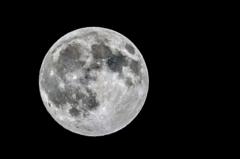Will Bonfire Night's Beaver Supermoon Be the Biggest and Brightest of 2025?

Published: 2025-11-02 06:00:27 | Category: technology
The Beaver Moon on Bonfire Night, 5 November 2025, will be a spectacular event as it marks the second supermoon of the year, rising at approximately 15:55 GMT. This full moon will be the largest and brightest of 2025, providing a perfect backdrop for fireworks displays across the UK. To catch this celestial phenomenon, observers should monitor weather forecasts for clear skies, especially since the moon will be at its closest point to Earth, enhancing its visual appeal.
Last updated: 01 November 2023 (BST)
What’s happening now
The upcoming Beaver Moon on 5 November 2025 is generating excitement among astronomy enthusiasts and the general public alike. Falling on Bonfire Night, this supermoon coincides with traditional firework displays, making it a unique occasion for skywatchers. As the moon approaches its perigee—30,000 miles closer than at its furthest point—the spectacle promises to be visually stunning, appearing potentially up to 14% larger and 30% brighter than normal full moons.
Key takeaways
- The Beaver Moon will rise on 5 November 2025 at around 15:55 GMT.
- This full moon coincides with Bonfire Night, enhancing fireworks displays.
- It will be the closest supermoon of the year, making it the largest and brightest moon visible.
- Weather conditions may vary, with the best viewing likely in northern regions of the UK.
- The term 'Beaver Moon' originates from Native American and European traditions and reflects seasonal changes.
Timeline: how we got here
Understanding the significance of the Beaver Moon involves looking back at its origins and the events leading to this year's occurrence:
- 1979: The term 'supermoon' was first coined by astrologer Richard Nolle.
- November 2024: The Harvest Moon marked the first supermoon of the season.
- 5 November 2025: The Beaver Moon will rise, coinciding with Bonfire Night celebrations.
- 4 December 2025: The final supermoon of the year is set to occur.
What’s new vs what’s known
New today/this week
Recent forecasts indicate a mix of weather conditions leading up to Bonfire Night, which may impact visibility of the Beaver Moon. While clouds and potential rain are expected in southern regions, northern areas might experience clearer skies, enhancing the chances of a spectacular view.
What was already established
The Beaver Moon is named after the time of year when beavers are most active in preparing for winter. Historically, beavers were heavily hunted in the UK, leading to their extinction in the 16th century. Today, rewilding efforts are underway to reintroduce these animals to their natural habitats.
Impact for the UK
Consumers and households
The Beaver Moon's occurrence on Bonfire Night means many families will enjoy firework displays under a bright sky. This event may influence local celebrations, with communities organising events that integrate the moon's visibility into their festivities.
Businesses and jobs
Fireworks vendors and event organisers are likely to see an uptick in business as families seek to celebrate Bonfire Night. The visibility of the Beaver Moon may also attract tourists to locations known for their fireworks displays, promoting local economies.
Policy and regulation
Local authorities may issue guidelines regarding firework safety and environmental considerations during the celebrations. The clear visibility of the Beaver Moon could lead to increased public interest in astronomy, prompting educational initiatives or community events focused on celestial observations.
Numbers that matter
- 30,000 miles: The distance by which the moon will be closer to Earth at perigee compared to apogee.
- 220,000 miles: The average distance of the moon from Earth at its closest point.
- 250,000 miles: The average distance of the moon from Earth at its furthest point.
- 14%: The estimated increase in size of the supermoon compared to a regular full moon.
- 30%: The increase in brightness of the supermoon compared to a regular full moon.
Definitions and jargon buster
- Supermoon: A full moon that coincides with the moon's perigee, appearing larger and brighter than usual.
- Perigee: The point in the moon's orbit when it is closest to Earth, approximately 220,000 miles away.
- Apogee: The point in the moon's orbit when it is furthest from Earth, around 250,000 miles away.
- Beaver Moon: The full moon in November, named for the time beavers are active in preparing for winter.
How to think about the next steps
Near term (0–4 weeks)
As Bonfire Night approaches, keep an eye on weather forecasts to determine the best locations for viewing the Beaver Moon. Local events may be organised to celebrate this unique occurrence, integrating both the moon and fireworks into the festivities.
Medium term (1–6 months)
After the Beaver Moon, attention will shift to the final supermoon of 2025 on 4 December. This may also be an opportunity for communities to host events that educate the public about lunar phenomena.
Signals to watch
- Weather forecasts for clear skies on Bonfire Night.
- Local event announcements related to Bonfire Night celebrations.
- Public interest in astronomy and moon-related activities in the months following the Beaver Moon.
Practical guidance
Do
- Check local weather forecasts leading up to Bonfire Night to identify the best viewing spots for the Beaver Moon.
- Participate in community events that celebrate both the moon and Bonfire Night.
- Consider safe practices when using fireworks to ensure a safe environment for all.
Don’t
- Don’t forget to observe safety guidelines when attending fireworks displays.
- Don’t ignore local weather updates that may affect visibility.
- Don’t miss the opportunity to learn about lunar phenomena and how they affect natural cycles.
Checklist
- Check local events for Bonfire Night celebrations.
- Monitor weather conditions for optimal moon visibility.
- Plan your viewing location ahead of time, preferably away from city lights.
- Bring binoculars for a better view of the moon.
- Prepare for safety if using fireworks, ensuring you have the necessary equipment and knowledge.
Risks, caveats, and uncertainties
As with any astronomical event, visibility can be affected by weather conditions. Forecasts may change as Bonfire Night approaches, and it is advisable to remain flexible with viewing plans. Additionally, the term 'supermoon' is not strictly defined, leading to some variations in how these events are perceived in the public domain.
Bottom line
The Beaver Moon on Bonfire Night is set to be a breathtaking event that combines cultural celebration with natural beauty. As this supermoon rises, it presents an opportunity for the public to engage with both astronomy and community festivities. With the right preparations, observers can enjoy a memorable night under one of the brightest moons of the year.
FAQs
What is a supermoon?
A supermoon occurs when a full moon coincides with the moon's perigee, making it appear larger and brighter than usual.
When will the Beaver Moon rise in 2025?
The Beaver Moon will rise on 5 November 2025 at approximately 15:55 GMT.
Why is it called the Beaver Moon?
The term Beaver Moon is thought to originate from Native American cultures, reflecting the time of year when beavers are preparing for winter.



